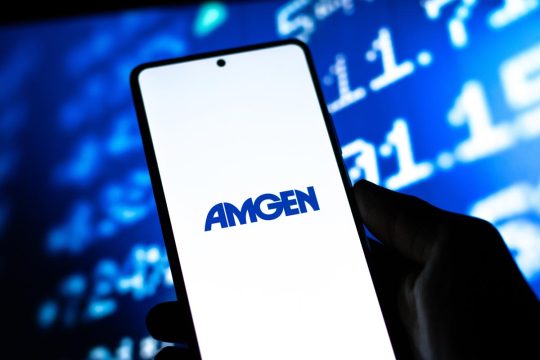Advertisment
New two-year data for Vabysmo and Susvimo reinforce potential to maintain vision with fewer treatments for people with two causes of vision loss – Genentech/Roche

Genentech, announced that new two-year data from its Phase III studies of Vabysmo (faricimab-svoa) and Susvimo (ranibizumab injection) 100 mg/mL for intravitreal use via ocular implant will be presented at Angiogenesis, Exudation and Degeneration 2022 on Feb. 12. These longer-term results from the Vabysmo YOSEMITE and RHINE studies in diabetic macular edema (DME) and the Susvimo Archway study in wet, or neovascular, age-related macular degeneration (AMD) further reinforce the potential to allow for longer time between treatments and fewer eye injections for people with these conditions, while still achieving and maintaining vision gains seen with previous standard-of-care injections. Wet AMD and DME are two leading causes of vision loss, together affecting nearly 2 million people in the U.S., which require treatment with eye injections as often as once a month.
In the YOSEMITE and RHINE studies , at least 60% of people eligible for extended dosing with Vabysmo could be treated every four months at two years – a 10 percentage point increase since the primary analysis at one year – while achieving non-inferior vision gains versus aflibercept given every two months. Furthermore, nearly 80% of people eligible for extended dosing with Vabysmo could be treated every three months or longer. In the Archway study, Susvimo allowed 95% of people to go six months between treatments at two years – the fourth complete refill-exchange interval – while maintaining vision outcomes that were non-inferior to monthly ranibizumab injections. Across all three studies, with longer follow-up, Vabysmo and Susvimo continued to be generally well tolerated, with favorable benefit-risk profiles. Safety will continue to be monitored closely in the post-market setting.
Vabysmo is the first bispecific antibody for the eye approved by the FDA and the only injectable eye medicine approved for treatments from one to four months apart in the first year following four initial monthly loading doses, based on evaluation of the patient’s anatomy and vision outcomes. Vabysmo is designed to block two disease pathways linked to a number of vision-threatening retinal conditions by neutralizing angiopoietin-2 (Ang-2) and vascular endothelial growth factor-A (VEGF-A). Ang-2 and VEGF-A are thought to contribute to vision loss by destabilizing blood vessels, which may cause new leaky blood vessels to form and increase inflammation. While additional research continues, inhibition of both pathways has been shown in preclinical studies to have potentially complementary benefits, stabilizing vessels and thereby reducing vessel leakage and inflammation more than inhibition of VEGF-A alone.
Susvimo is the first wet AMD treatment in 15 years to provide an alternative to standard-of-care eye injections. By continuously delivering medicine into the eye through a refillable implant, Susvimo is the only FDA-approved treatment that may help people with wet AMD maintain their vision with as few as two treatments per year.
Vabysmo: YOSEMITE and RHINE Two-Year Results :In the YOSEMITE and RHINE studies, DME patients received Vabysmo, given either every two months or up to every four months using a treat-and-extend approach, or aflibercept given every two months. Two-year results showed Vabysmo patients maintained the vision improvements achieved in the first year and vision gains continued to be non-inferior to those achieved by aflibercept patients. In YOSEMITE, the average vision gains from baseline at two years were +10.7 eye chart letters in both the Vabysmo treat-and-extend and two-month arms, and +11.4 letters in the aflibercept arm. In RHINE, the average vision gains from baseline at two years were +10.1 and +10.9 letters in the Vabysmo treat-and-extend and two-month arms, respectively, and +9.4 letters in the aflibercept arm.
Importantly, 60% (n=162/270) of Vabysmo treat-and-extend patients in YOSEMITE and 64.5% (n=185/287) in RHINE achieved four-month dosing at two years. This is an increase over one-year results, which showed 52.8% (n=151/286) of Vabysmo treat-and-extend patients in YOSEMITE and 51% (n=157/308) in RHINE achieved four-month dosing. An additional 18.1% (n=49/270) of Vabysmo treat-and-extend patients in YOSEMITE and 13.6% (n=39/287) in RHINE achieved three-month dosing. Combined, almost 80% of Vabysmo treat-and-extend patients were able to go three months or longer between treatments at the end of the second year.
Across study arms, Vabysmo showed consistent two-step or better improvement in diabetic retinopathy according to the Early Treatment Diabetic Retinopathy Study – Diabetic Retinopathy Severity Score (ETDRS-DRSS). At two years, 42.8% of Vabysmo treat-and-extend patients in YOSEMITE and 44.3% in RHINE achieved a two-step or better improvement from baseline. In the two-month Vabysmo arms, 51.4% and 53.5% of patients in YOSEMITE and RHINE, respectively, achieved a two-step or better improvement in diabetic retinopathy severity.
Vabysmo given at intervals of up to four months continued to demonstrate greater reductions in central subfield thickness (CST) compared to aflibercept given every two months in both studies. Safety results were consistent across study arms, with no cases of retinal vasculitis or retinal occlusive events.
One-year results from the YOSEMITE and RHINE studies and the TENAYA and LUCERNE studies in wet AMD were recently published in The Lancet. ( previously cited)
Susvimo: Archway Two-Year Results : Wet AMD patients in Archway received either Susvimo refilled every six months or monthly ranibizumab 0.5 mg eye injections. Two-year results showed vision was maintained by Susvimo patients and continued to be non-inferior to that achieved with monthly ranibizumab injections. Susvimo patients averaged -1.1 eye chart letters in visual acuity from baseline at two years, while monthly ranibizumab patients averaged -0.5 letters from baseline. In addition, 95% of Susvimo patients were able to go six months without needing additional treatment in the second, third and fourth refill-exchange intervals. In Archway, Susvimo was generally well tolerated, with a favorable benefit-risk profile. The most common adverse events of special interest ( greater than 5%) were cataract, conjunctival bleb and vitreous hemorrhage. The safety profile of Susvimo in the clinical trial setting is well understood and will continue to be monitored closely. In addition to Archway results, two-year interim data from the ongoing Phase III Portal study will be presented at the Angiogenesis meeting. Portal is an extension study evaluating the long-term safety and efficacy of Susvimo in wet AMD.
Vabysmo is approved by the FDA for the treatment of wet AMD and DME. Susvimo is approved by the FDA for the treatment of people with wet AMD who have previously responded to at least two anti-VEGF injections. Vabysmo is currently under review by the European Medicines Agency for the treatment of wet AMD and DME and Susvimo is under review for the treatment of wet AMD. Submissions to other regulatory authorities around the world are ongoing.
Genentech has a robust Phase III clinical development program for Vabysmo and Susvimo. For Vabysmo, the program includes AVONELLE-X, an extension study of TENAYA and LUCERNE evaluating the long-term safety and tolerability of Vabysmo in wet AMD, and RHONE-X, an extension study of YOSEMITE and RHINE evaluating the long-term safety and tolerability of Vabysmo in DME. Additionally, the COMINO and BALATON trials are also underway, evaluating the efficacy and safety of Vabysmo in people with macular edema following retinal vein occlusion.
For Susvimo, the clinical development program includes the Portal, Pagoda, Pavilion and Velodrome studies. Portal is an extension study evaluating the long-term safety and efficacy of Susvimo in wet AMD. Pagoda is evaluating Susvimo for the treatment of DME, while Pavilion is a study of Susvimo in diabetic retinopathy without DME. Velodrome is evaluating Susvimo refilled every nine months in wet AMD.





